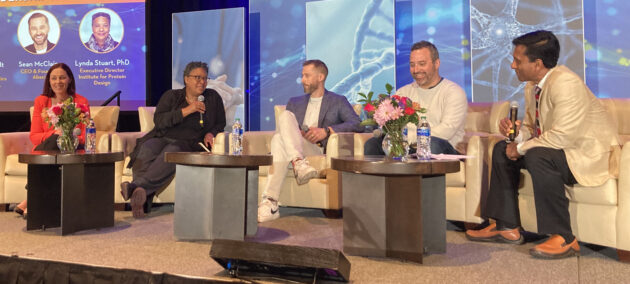
The culture of collaboration in the Pacific Northwest, the impact of AI on biopharma, and the shape of new business models driven by AI were all topics at a panel discussion Wednesday in Seattle at the 2024 Life Science Innovation Northwest meeting.
“The Pacific Northwest has the compute, it has the biotech, but it also has a kind of culture of collaboration and sharing that is not present in certain other parts of the country,” said Lynda Stuart, executive director of the Institute for Protein Design (IPD) at the University of Washington.
“A regional hub is a very natural thing to emerge,” said Portland, Ore.-based Jonathan Cohen, vice president of applied research at NVIDIA.
The IPD is at the center of this hub, connecting AI with biotech. The IPD generates open-source AI tools to craft protein-based therapeutics, vaccines, materials and biosensors, and its Seattle-area spinouts and affiliated companies interact with each other and partner with larger biopharma companies. Big tech companies are also investing in the area; in September, Microsoft released an open-source model to generate proteins.
One major aim is to not only discover new therapeutic proteins but to shorten their clinical development through “quality by design,” said Stuart. Researchers can now assess proteins for traits such as ease of manufacture or unwanted cross-reactivity to other molecules, she said.
The use of AI in biopharma also goes beyond protein design. Bristol Myers Squibb, which has more than 1,500 employees in the Seattle area, uses machine learning to mine internal data to match patients for clinical trials, said Danielle Greenawalt, scientific executive director of translational informatics and predictive sciences at BMS.
BMS is now able to conduct “virtual” clinical trials, and it uses models like ChatGPT to simplify protocols and consent forms, said Greenawalt.
The new AI tools are enabling companies to start progressing drugs to the clinic faster and at lower cost, said Sean McClain, CEO of Vancouver, Wash.-based biotech company Absci, one of the few regional companies in the field that is not an IPD spinout.
In the future, researchers will have increased ability to predict the biological properties of their computationally-designed therapeutics, added McClain.
A lot of the recent advances have origins in Washington state research, he said. “There’s really a special environment being created here,” said McClain.
Panelists also talked about how new ways to generate, standardize and collate biological data would make AI models more powerful. Pharma companies are investing in “pre-competitive” consortiums around specific diseases to learn from each other’s data and models, said Greenawalt. Other efforts to share data or resources include Seattle-based consortium OpenFold.
Nonetheless, “in biology, it is the case that a lot of the high-quality data in the world is locked up in proprietary databases,” said Cohen.
In the end, proprietary data may be a differentiator for companies tapping into an increasing number of open-source AI models, said panelists.
Cohen sees a business model where companies add their own data, fine-tuning, and internal expertise to open-source platform tools. He pointed to NVIDIA’s proprietary chip design process as an example. The company has trained an open-source large language model on NVIDIA internal documentation and code, to generate an AI-powered chip design system unique to the company.
“The creation of these shared community foundation models really becomes a platform on top of which everybody goes and does their own thing,” said Cohen. “And I think there’s a very good argument that that economically makes a lot of sense in the life sciences as well.”
It’s important that such platform models, like those made by the IPD, originate with publicly-funded universities, said Stuart. “That’s a unique asset to the region, and for the world,” said Stuart.
Researchers, institutions and companies are still working out the balance between keeping data and “rising all boats” by sharing it, said Stuart. How that plays out has implications for how new companies are built, she said — data may become the commodity around which new companies emerge.
“This is a question for the community and the ecosystem: how much are our people going to be proprietary around their own foundation model, versus how much are they just going to share?” said Stuart.


